Cucumber tapeworm in cats: causes, symptoms and treatment
Cucumber tapeworm in cats is found more often than other animals. This disease is also called dipylidiosis and is caused by the tapeworm, which lives mainly in the small intestine. The disease is dangerous not only for pets, sometimes the owner is also susceptible to infection. It is necessary to diagnose the parasite in time and conduct treatment, otherwise the complications can be very serious.
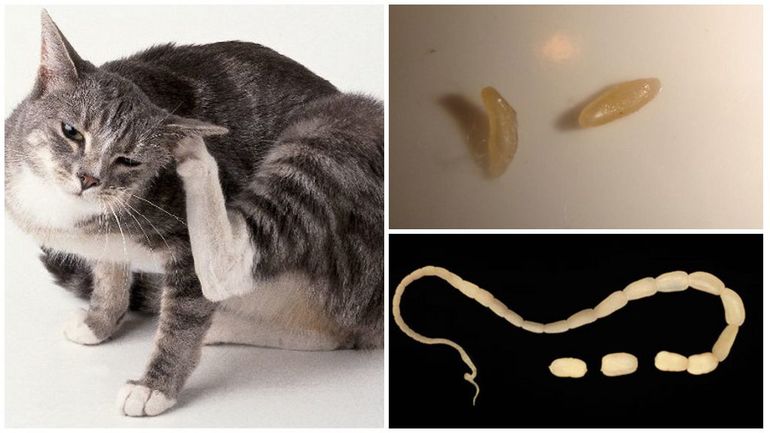
General information
In the process of life, tapeworm changes several carriers, one of which is intermediate. Larvae of the parasite are eaten by lice eaters and fleas, most often they are considered as carriers. Permanent residence are animals that lick their coat after them. Having penetrated inside the pet, the worm attaches to the membrane of the small intestine. The development of cucumber tapeworm in cats and dogs occurs within 4 weeks, then the parasite emerges in the form of separate parts of the body that are filled with larvae. Each segment may contain more than 25 individuals.
Some of the worms that have left remain on the coat of the pet, while others spread through the habitat and await the next carrier.
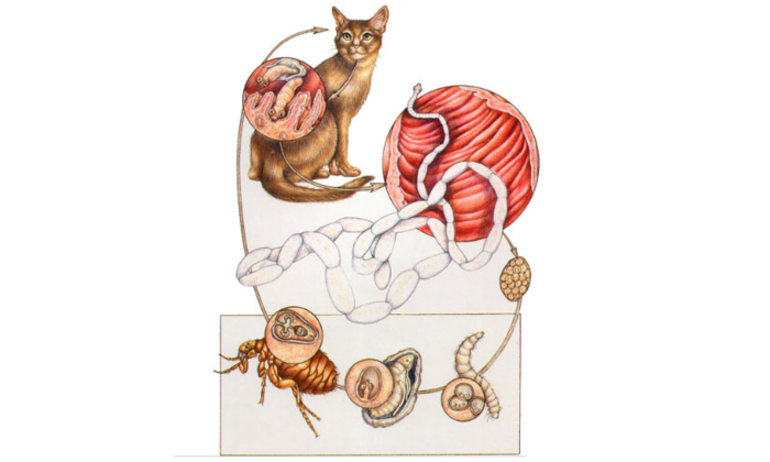
You can get a parasite anywhere. The highest concentration of worms is observed in nurseries in which there are a large number of animals or in areas for walking. A pet is as easily infected as a stray cat or dog. People get infected infrequently. Children are most at risk because they are more likely to contact their pets.
Infection of a person with dipyridiosis is random. The parasite can penetrate while swallowing the saliva of a pet or infected flea or while eating dirty vegetables and fruits.
Symptoms in a cat
During a recent infection and in the initial stages of the disease, it is impossible to determine the parasite in the body of the animal. Signs appear when the cat begins to weaken, every day, being exposed to toxic decay products that secrete worms during life. In addition to intoxication, the appearance of intestinal obstruction and allergic reactions is also noted.
Possible symptoms:
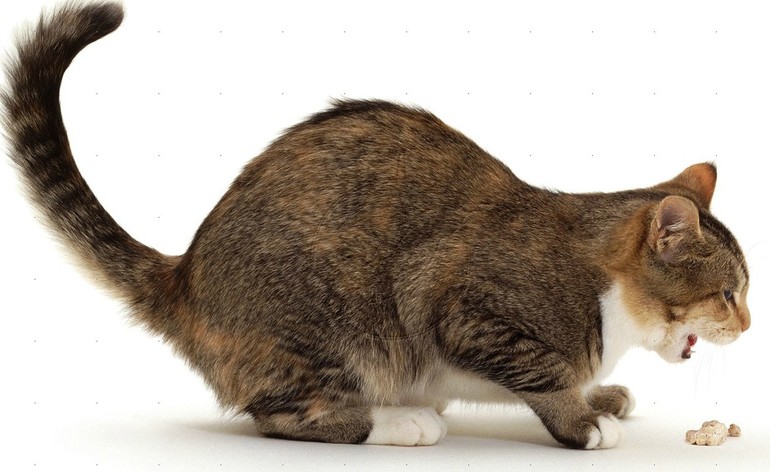
- digestion disorder;
- periodic urge to vomit;
- anxiety;
- significant weight loss;
- loss of appetite.
In some cases, the disease is asymptomatic or the symptoms are blurred. In order to timely identify the disease, the owner of the cat needs to inspect the animal’s tray more often, as a rule, it is here that you can see the worms. Despite the small size, the segments of the bull’s tapeworm are visible to the naked eye. During the detection of parasites in the tray, you should contact the veterinarian as quickly as possible and begin to treat the animal.
If the defeat has already happened, then the cat has specific signs:
- tousled hair;
- pain in the abdomen;
- loose stools;
- discharge from the eyes.
When the larvae of the worms leave the body, they settle on the cat's hair, which prevents the animal from putting itself in order. A pet rarely licks itself, becomes lethargic and groomed. In the area of the anus, redness and irritation are noted, and the cat begins to "ride" on the floor, trying to relieve itching.
In addition, worms cause intoxication, because the animal suffers from nausea. At the same time, the pet absorbs food with a vengeance, since cucumber tapeworm simply sucks out all the nutrients from the cat.
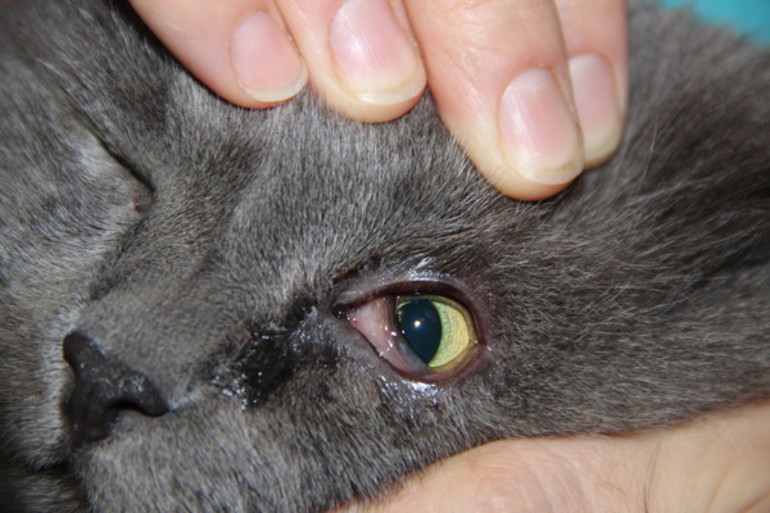
During infection with tapeworms, the animal often has purulent discharge from the eyes, and the pet becomes lethargic and lethargic. Not infrequently, this is replaced by nervousness, sometimes even aggression towards the owner.
Serious complications can be avoided during timely diagnostic measures and treatment.. If the disease is in a serious stage, the development of the following pathologies is likely:
- pancreatitis
- gastritis;
- colitis;
- enteritis;
- cholecystitis.
The death rate from these diseases is very high, especially in kittens, as a rule, they die.
Treatment methods
Bringing cucumber tapeworm in cats is possible only with complex treatment. In addition to anthelmintic medications, cutaneous parasite preparations are also used, and a restorative diet is also needed. During therapeutic procedures, habitat should be sanitized using disinfectant formulations.
It is important to choose the right medicines that are effective and safe for the cat. Medications are usually given once a day, until the first meal in the morning. The dosage is selected individually for each pet, taking into account its lifestyle and weight. The most commonly used medications are as follows:
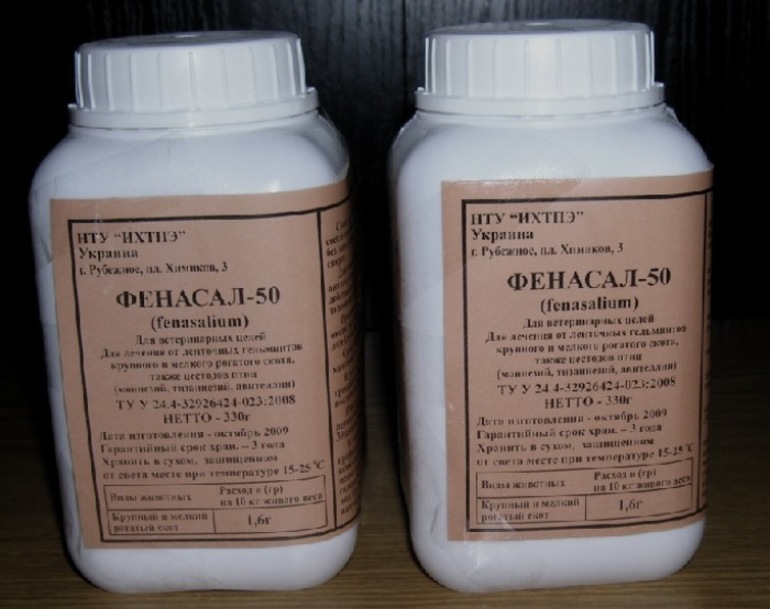
- Phenasal - the drug is sold in powder form. It needs to be added once to the animal’s feed, and the medicine is calculated taking into account the weight of 0.2 g per 1 kg of pet weight. It costs about 2800 rubles.
- Medicines that contain praziquantel as an active ingredient (for example, Drontal, Quantum). These drugs are prescribed on the basis that 1 mg of the drug is required per 1 kg of animal weight. Price - 220-440 rubles.
- Bunamidine is calculated per 1 kg of cat weight of 30-40 mg. The medicine is given once a day 3 hours after a meal.
- Mebendazole is used for 3 days at 45 mg per 1 kg of animal weight. This medication can be added to cat food. Cost - 80 rubles.
- Phenagel - the product is made in the form of a paste and is given to the animal in the morning before eating. For 1 kg of cat's body weight, 0.1 g of the drug is required. The paste must be placed on the tongue of the animal under its root. In order for the pet to swallow the product faster, it is necessary to raise its head and scratch its neck from top to bottom. This causes a swallowing reflex. The cat can be released only after it has begun to lick, which indicates that the medicine was swallowed.
Antibiotics may be prescribed if it is necessary to destroy the microorganisms that have joined as a secondary infection. This should be determined only by the veterinarian.
Diagnostic measures
The owner can perform the initial diagnosis of the animal for the presence of worms at home. Why do you need to carefully examine the contents of the tray. Tapeworm larvae are round or oval in shape. They simply cannot be seen in the stool, in which they are in the form of clumping lumps and contain up to 25 individuals. In the feces, it is possible to observe the segments remaining from the parasite. But only a laboratory study can confirm that the detected one is the presence of a bovine tapeworm in the body, so the animal should be taken to the veterinarian.
The doctor will listen to the owner’s complaints, examine the cat and prescribe:
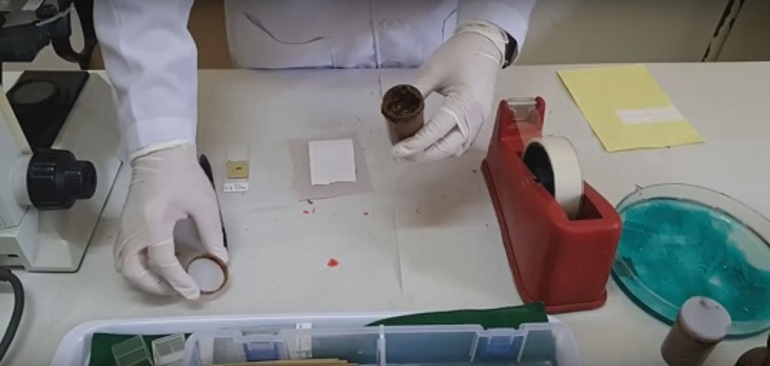
- the study of feces by the Fulleborn method;
- urinalysis;
- blood analysis.
The Fulleborn method consists in the fact that the particles of feces are dissolved in saline, then filtered and settled. Surfaced larvae are examined with a microscope. It is this method of diagnosis that makes it possible to classify a variety of tapeworm from many other species.
Disease prevention
The eggs themselves are not dangerous for the pet. Immature larvae, having penetrated the body of a potential carrier, are simply digested in the stomach without causing any harm to health. The main condition for the development of tapeworm is the maturation of the egg in the body of the intermediate host, usually fleas.Therefore, all preventive measures that will help prevent infection are required to be directed to the destruction of these insects.
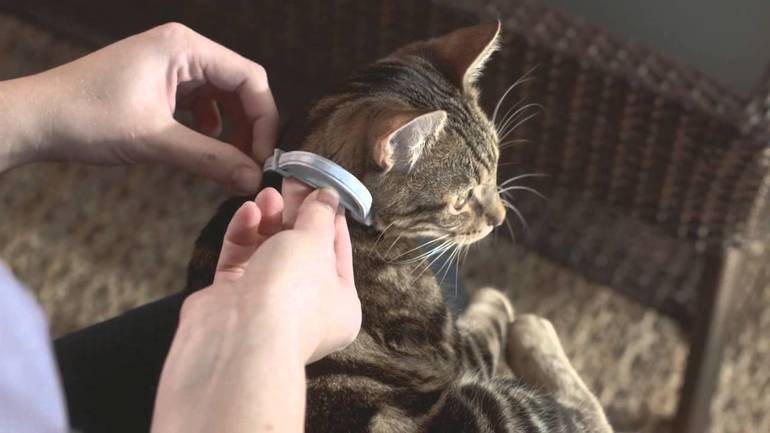
You need to teach a cat to wear a collar, periodically baiting fleas with special means. For prophylaxis, it is constantly necessary to treat them with animal bedding, houses and ottomans. All things that can be removed and washed should be washed in hot water.
Processing of all rooms is also desirable. For this, you can use any drug, for example: solutions of malathion, chlorophos, Actor, Perol.
To effectively process the apartment, you must:
- Perform a general cleaning, remove dirt from all corners where flea larvae can be.
- Remove carpets, put furniture away from the wall.
- It is necessary to spray with a spray all places in which parasites can be.
- The apartment should be “infused” 2-3 hours, then it is aired.
- Carpets need to be pulled out, vacuumed floors, wet cleaning again.
If insects remain, then with a high degree of probability infection with worms will occur again.
To protect yourself from tapeworms, you must:
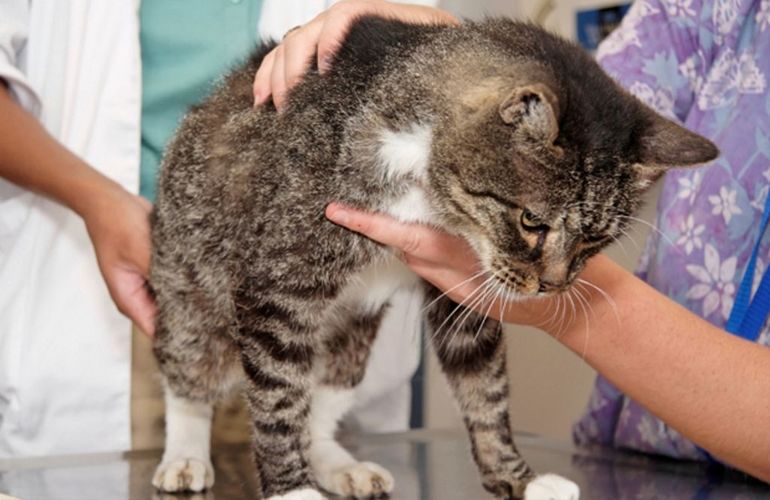
- provide animals with flea-collars or regularly bathe them with special shampoo for prevention;
- regularly check the coat of pets for the presence of fleas, and if detected, carry out appropriate treatment;
- Maintain cleanliness in the house;
- wipe shoes after returning from the street;
- exclude unwashed vegetables and non-frozen meat from the animal’s menu;
- ensure the hygiene of trays and bowls, including their regular treatment with antiseptics;
- remember the prevention of helminthic invasions in family members;
- wipe with disinfectants the floor, furniture and other surfaces on which cats like to be;
- regularly give anthelmintic to pets: once on a walk in the street - once every six months, with a constant stay at home - once every 12 months.
Danger to humans
Directly, the borage feels great both in the body of animals and in the body of people. However, it is very difficult for a person to become infected with bovine tapeworm, since the principle of the appearance of the disease remains the same - you need to swallow an infected cat flea or saliva. This trouble is most likely to happen only with children who are constantly in contact with a pet.
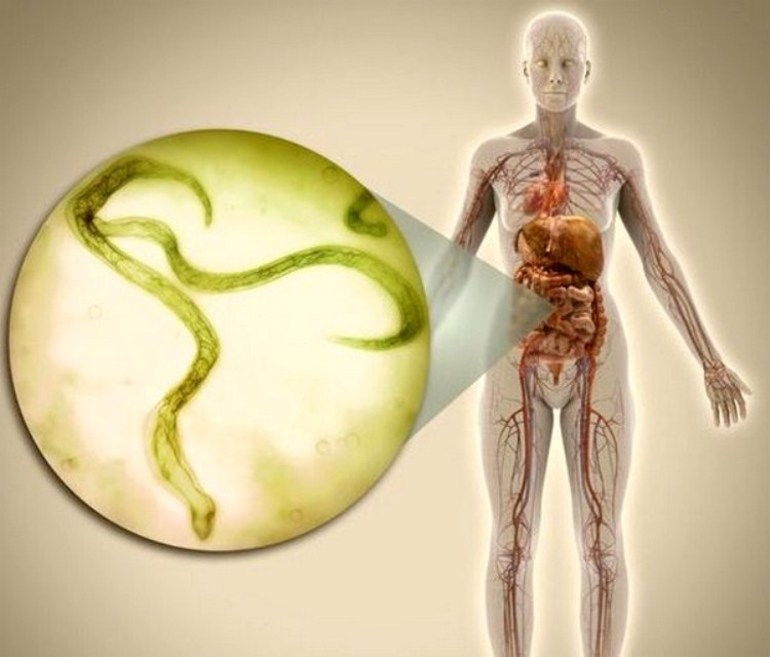
The tapeworm develops in the human body in the same way as in the cat's body. About 4 weeks after infection, the worm grows to 15–20 cm and larvae lays.
But, despite the large size of the worm, its vital activity does not often cause discomfort to the wearer.
The disease, as a rule, goes away without symptoms and only in rare cases the following is likely:
- Indigestion.
- Pain in the navel.
- Itching in the anus.
- Poor appetite.
- Dizziness, sleep disturbance, anxiety.
- Pallor of the skin.
Diagnostic measures of infection come down to an examination of feces, which probably needs to be done several times.
Treatment consists of taking products that contain praziquantel. Use drugs once in a dosage, which is calculated in the proportion of 7-12 mg per 1 kg of human weight. Alternatively, agents may be used where niclosamide is present as the active ingredient. Anthelmintic drugs based on it are also taken once in a dosage of 3 g. To confirm the result of therapy, re-delivery of feces to the examination is necessary.
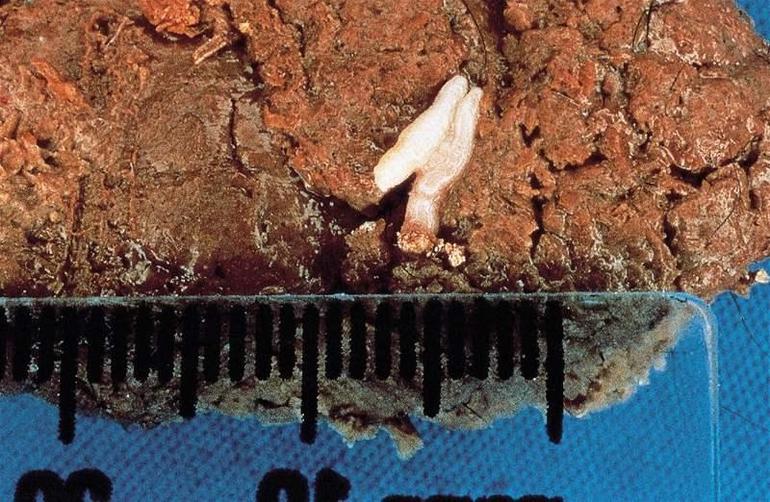
If white blotches that resemble rice or cucumber seeds are detected in the feces, there is no need to rush to independently diagnose infection with feline dipylidiosis. It is necessary to pass feces to the laboratory in order to exclude infection with other varieties of tapeworm.
For humans, the chain worm is considered conditionally dangerous. In the human body, the parasite, as a rule, is not more than one year, then dies.Children due to underdeveloped immunity, it is easier to contract dipyldiosis. Basically, babies become infected at the age of 5-12 years old, who play with street animals. Finding worms in a child's body can lead to an allergic reaction, regular colds, and weight loss. If a disease is determined in a timely manner in a person, then it can be easily treated.
- How to choose a vacuum cleaner taking into account the characteristics of the house and coatings?
- What to look for when choosing a water delivery
- How to quickly create comfort at home - tips for housewives
- How to choose the perfect TV - useful tips
- What to look for when choosing blinds
- What should be running shoes?
- What useful things can you buy in a hardware store
- Iphone 11 pro max review
- Than iPhone is better than Android smartphones



